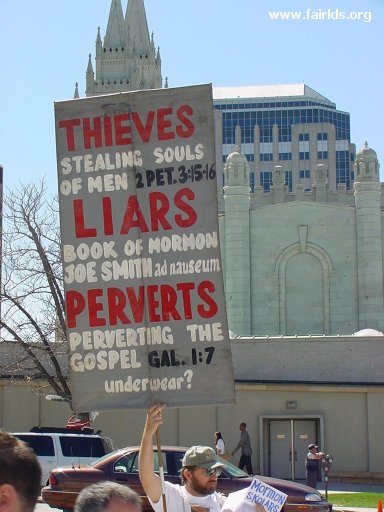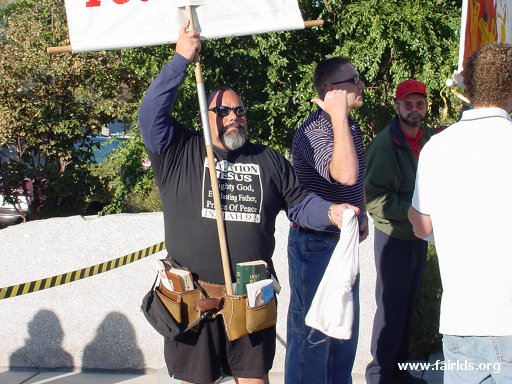
FAIR is a non-profit organization dedicated to providing well-documented answers to criticisms of the doctrine, practice, and history of The Church of Jesus Christ of Latter-day Saints.
| Answers portal |
| Temples |

|
|
General:
Endowment: Masonry: |
Important note: Members of FAIR take their temple covenants seriously. We consider the temple teachings to be sacred, and will not discuss their specifics in a public forum.
This article is a draft. FairMormon editors are currently editing it. We welcome your suggestions on improving the content.
Hostile critics often mock the LDS practice of wearing temple garments. They refer to these parts of our worship as "magic underwear" to shock, offend, or hold up to ridicule.

Members of the Church are often subjected to critics—generally conservative protestants—who picket their meetings and temple dedications. It is not unusual for such protesters to display LDS temple garments, hold them up to ridicule, or treat them with disrespect. Protesters and authors often disparage the LDS wearing of the garment as "magic underwear," and insist that doing so is a unbiblical practice. (See here for photos and videos of several anti-Mormon demonstrations.]
Such actions are grossly offensive to Latter-day Saints. Only an attack on the character or name of Jesus would be worse, since the garment is tied closely to the LDS worship of Christ.
This section will explain the meaning of the garment in LDS theology and practice, and address charges that the use of clothing with sacred significance is "unChristian" or "unbiblical."
Under the heading of Pre-endowment Instructions, McKeever and Johnson enter into a discussion on the nature of the 'temple garments.' In regards to this garment, the authors write: "By wearing the garments at all times, it is taught that the individual Mormon, depending on his or her faithfulness, is protected both physically and spiritually."[1] It is clear from the ensuing discussion that rather than focusing on the fundamental belief in a 'spiritual protection,' that McKeever and Johnson, in trying to sensationalize their account, are much more interested in the 'physical protection.' From the end of the section, where they end up comparing the garment to a "proverbial rabbit's foot or talisman," we see that they have little interest in accurately portraying Mormon beliefs. To begin with, they take a quote from a prominent LDS leader, Spencer W. Kimball, which might support such an interpretation. The quote reads:
President Kimball here expresses his view that the protection is generally spiritually, though one cannot rule out the possibility that God would grant physical protection. Surely God can do as he chooses?
McKeever and Johnson misrepresent this statement, however. They introduce the citation with the words: "For instance, President Spencer W. Kimball said on 31 May 1948:" First (and this is also dealt with in the second part of this review) Spencer W. Kimball was not the President of the Church in 1948 when these remarks were written. He was, however, an apostle, having been ordained to that calling in 1943, and would become the President of the Church in 1973. Second, while McKeever and Johnson suggest that this was spoken by Kimball, in fact, this is excerpted from a personal letter written by Kimball in 1948 and a copy kept by him in his personal things. So, while it is true that it was written by Kimball, this hardly seems to carry the degree of authority which is lent to it in Mormonism 101 and some other critics' use of it. We are left with the realization that this is a personal opinion and not a doctrinal statement. We could recognize from his statement that while he sees the garment as having acted as a physical protection in many cases, he certainly never goes so far as to suggest that it does in all cases, nor, that we should expect it to function in that manner.

Boyd K. Packer, in his book, The Holy Temple, is explicit in what he feels this protection is:
McKeever and Johnson also make the remark: "Mormons who remain true to the faith and wear the garments believe they will be protected." [4] While all LDS believe that there is a spiritual protection afforded by the garments, and some believe that there is a physical protection as well, the fact that this protection is in part dependent on the faith and worthiness of the wearer is merely another indicator that the garment cannot be compared to a 'lucky talisman.'
At this point, McKeever and Johnson change course and attack the practice of wearing the garment by trying to show how its use in the LDS Church is inconsistent with the use of similar garments in the Old Testament. They write:
Although McKeever and Johnson do not mention this fact, Latter-day Saints assert that the garments of the priesthood received in the house of the Lord are representative of several things. First and foremost, we learn that these garments are representative of the coat of skins God gave to Father Adam to cover his nakedness. Theodore M. Burton said the following in a speech given at BYU on August 8th, 1966:
There is a repetitive theme in the Old Testament where nakedness and shame are associated with sin, and a covering, or a garment with righteousness. In 3/3-4.{{{4}}}?lang=eng#{{{4}}} Zechariah 3 3-4:{{{4}}} we get a narrative describing the calling of Joshua the High Priest:
In Isaiah 47:3, speaking prophetically to wayward Israel, we read these words of the Lord: "Thy nakedness shall be uncovered, yea, thy shame shall be seen: I will take vengeance, and I will not meet thee as a man." There are many more instances, but perhaps the most significant to this discussion is the treatment of the special garments given to the Levitical priests.
A brief description of these special garments made for the priests is found in Exodus 28:. Especially relevant are verses 42 and 43.
Critics might read this passage differently, but if taken literally then indeed there was some 'special protection' afforded by these garments. One of the points of interest here though, especially to LDS, is that this protection was only necessary when the Israelite approached God. As McKeever and Johnson pointed out, these garments were only required of the priests. In the LDS Church, the priesthood is offered to all worthy male members. The LDS practice is rooted in a similar theology.
The D&C makes this statement (DC 107꞉18-19) "The power and authority of the higher, or Melchizedek priesthood, is to … enjoy the communion and presence of God the Father and Jesus the mediator of the new covenant." In other words, this symbolic imagery of pure garments now necessarily covers our sins at all times, not just when we go "to minister in the holy place." Christians are to be a nation of priests, under Christ. It is therefore not surprising that LDS wear the reminder of their priestly duties—which are also reminders of Christ's all-covering atonement—at all times. They do not display them outwardly, for the reminder is for the individual member, not others.
In any case, it is the spiritual protection and reminder that remains at the forefront of LDS beliefs and practices regarding this garment. It is a reminder that we put on anew every day. It is a covering which sets a certain standard of modest dress. It is also a covering which would have to be removed before breaking many of the covenants of the temple. To this end, whether we believe that it serves us as a physical protection or not, its value to us is far above that of a mere protective covering. To us it is both a reminder and to the faithful, a witness of our willingness to obey our Father in Heaven. And it is from this context that LDS authorities' comments are drawn.
Temples of The Church of Jesus Christ of Latter-day Saints are sacred places where Church members participate in sacred ceremonies (ordinances) that help them come closer to God and prepare to live forever in an eternal family.
To view articles about Latter-day Saint temples, click "Expand" in the blue bar:
Baptism for the dead |
|
The temple endowment |
|
Temple sealings |
|
Other topics |
Videos below from The Church of Jesus Christ of Latter-day Saints.
| FAIR temple articles |
| Temple printed materials |

FAIR is a non-profit organization dedicated to providing well-documented answers to criticisms of the doctrine, practice, and history of The Church of Jesus Christ of Latter-day Saints.
We are a volunteer organization. We invite you to give back.
Donate Now